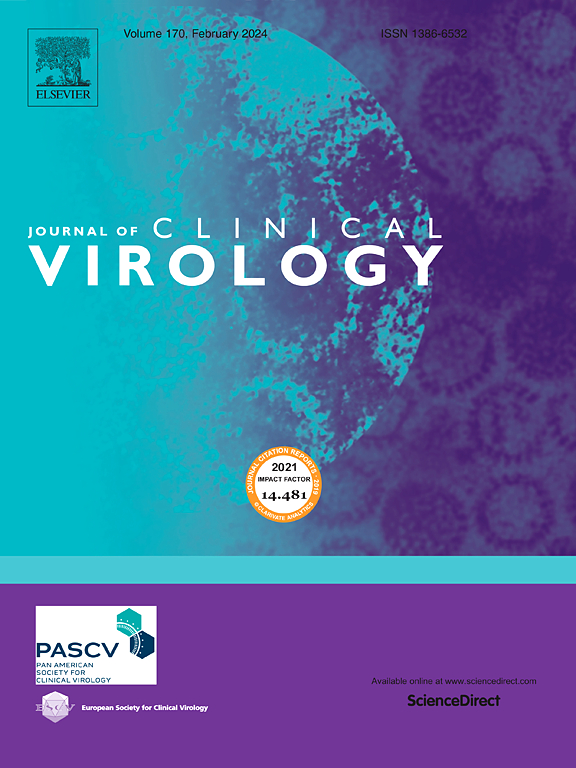HIV-1耐药的RNA和前病毒DNA基因分型检测在纵向和重复检测中都是可变的
IF 3.4
3区 医学
Q2 VIROLOGY
引用次数: 0
摘要
hiv -1变异含有耐药性相关突变(RAMs),可以储存在病毒储存库中,然后重新出现。鉴于潜伏库的动态特性和基因型分析的检测极限,RAM随时间的持久性尚不完全清楚。目的回顾性分析成人HIV感染者RAM的检测情况。研究设计纳入了3个比替格拉韦/恩曲他滨/替诺福韦阿拉那胺转换研究的蛋白酶、逆转录酶和整合酶基因分型。对来自≥2个开关前时间点的RNA和前病毒DNA基因型组合报告的参与者进行纵向分析。在2个时间点评估的ram被分类为100 %或50 %的检出率,在≥3个时间点评估的ram被分类为持续、丢失、获得或不一致的检出率。从每个全血样本中,前病毒RAM报告的再现性(%)是每次检测(2-4个重复)中检测到突变的次数。结果223名受试者中,2个时间点纵向追踪的262只RAMs中,39只 %(103/262)的检出率为100 %,61只 %(159/262)的检出率为50 %,64只 %(101/159)的检出率为2个时间点。在25名≥3个时间点的参与者中,57个ram的检测分为持续(19 %;11/57)、丢失(12 %;7/57)、获得(26 %;15/57)或不一致(42 %;24/57)。前病毒RAM检测在1个时间点的平均(标准差)重复性为80.9 %(27.2 %)(来自70名参与者的336只RAM)。结论纵向RAM检测模式不一致。原病毒基因分型的重复性高,但存在差异。由于ram并不总是被一致检测到,因此应考虑个体的累积耐药史以进行最佳治疗管理。本文章由计算机程序翻译,如有差异,请以英文原文为准。
Detection of HIV-1 drug resistance in RNA and proviral DNA genotyping is variable both longitudinally and during repeat testing
Background
HIV-1 variants harboring resistance-associated mutations (RAMs) can be archived in viral reservoirs and then re-emerge. Given the dynamic properties of the latent reservoir and detection limits of genotypic assays, RAM persistence over time is incompletely understood.
Objective
This retrospective analysis investigated RAM detection in adults with HIV.
Study design
Genotyping of protease, reverse transcriptase, and integrase from 3 bictegravir/emtricitabine/tenofovir alafenamide switch studies was included. Longitudinal analyses were performed for participants with combinations of RNA and proviral DNA genotype reports from ≥2 pre-switch timepoints. Reported RAMs assessed at 2 timepoints were categorized as 100 % or 50 % detection, and those assessed at ≥3 timepoints as persistent, lost, gained, or inconsistent detection. From each whole blood sample, reproducibility (%) of proviral RAM reporting was the number of times the mutation was detected per number of assays run (2–4 replicates).
Results
In 223 participants, of 262 RAMs tracked longitudinally over 2 timepoints, 39 % (103/262) had 100 % detection and 61 % (159/262) had 50 % detection, with 64 % (101/159) detected at timepoint 2. In 25 participants with ≥3 timepoints, detection of 57 RAMs was categorized as persistent (19 %; 11/57), lost (12 %; 7/57), gained (26 %; 15/57), or inconsistent (42 %; 24/57). Mean (standard deviation) reproducibility of proviral RAM detection at 1 timepoint was 80.9 % (27.2 %) (336 RAMs from 70 participants).
Conclusions
No consistent pattern of longitudinal RAM detection was observed. Reproducibility of proviral genotyping was high but variable. Since RAMs were not always consistently detected, an individual’s cumulative resistance history should be considered for optimal treatment management.
求助全文
通过发布文献求助,成功后即可免费获取论文全文。
去求助
来源期刊

Journal of Clinical Virology
医学-病毒学
CiteScore
22.70
自引率
1.10%
发文量
149
审稿时长
24 days
期刊介绍:
The Journal of Clinical Virology, an esteemed international publication, serves as the official journal for both the Pan American Society for Clinical Virology and The European Society for Clinical Virology. Dedicated to advancing the understanding of human virology in clinical settings, the Journal of Clinical Virology focuses on disseminating research papers and reviews pertaining to the clinical aspects of virology. Its scope encompasses articles discussing diagnostic methodologies and virus-induced clinical conditions, with an emphasis on practicality and relevance to clinical practice.
The journal publishes on topics that include:
• new diagnostic technologies
• nucleic acid amplification and serologic testing
• targeted and metagenomic next-generation sequencing
• emerging pandemic viral threats
• respiratory viruses
• transplant viruses
• chronic viral infections
• cancer-associated viruses
• gastrointestinal viruses
• central nervous system viruses
• one health (excludes animal health)
 求助内容:
求助内容: 应助结果提醒方式:
应助结果提醒方式:


